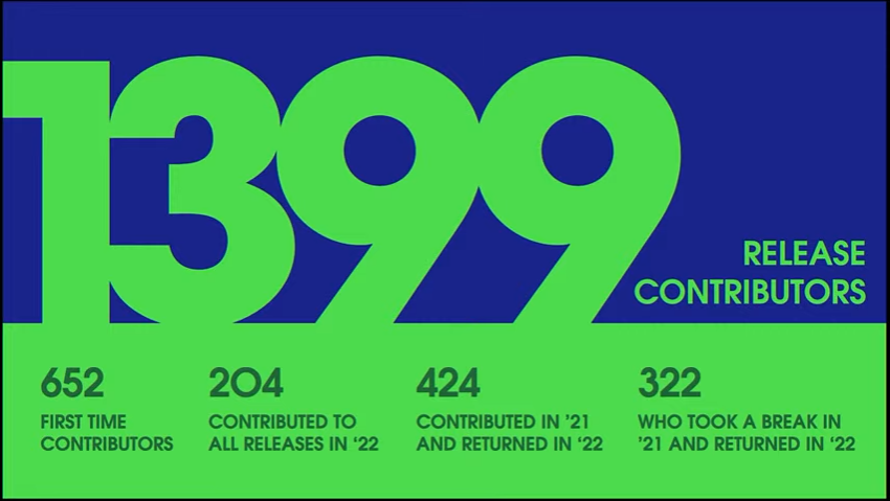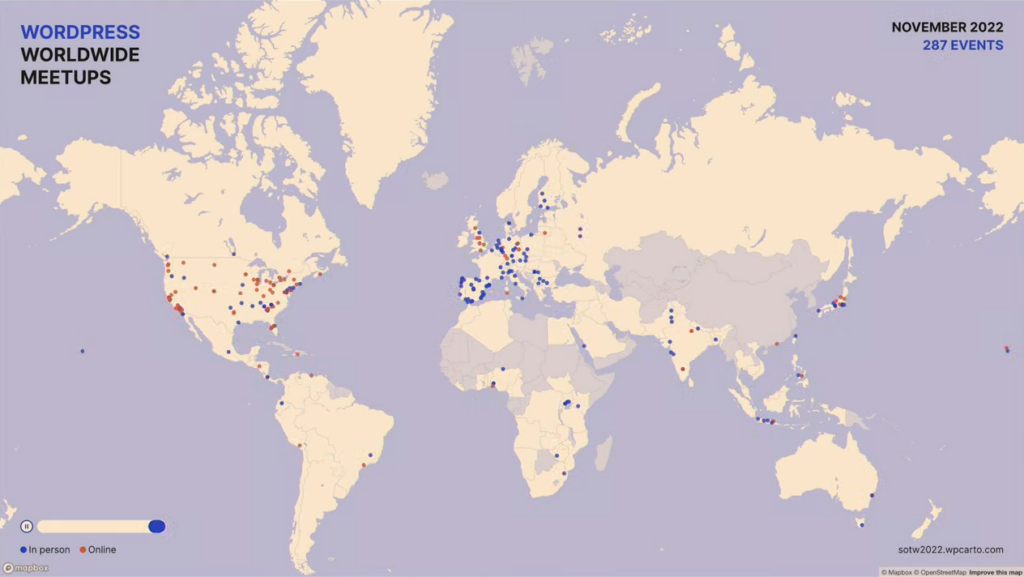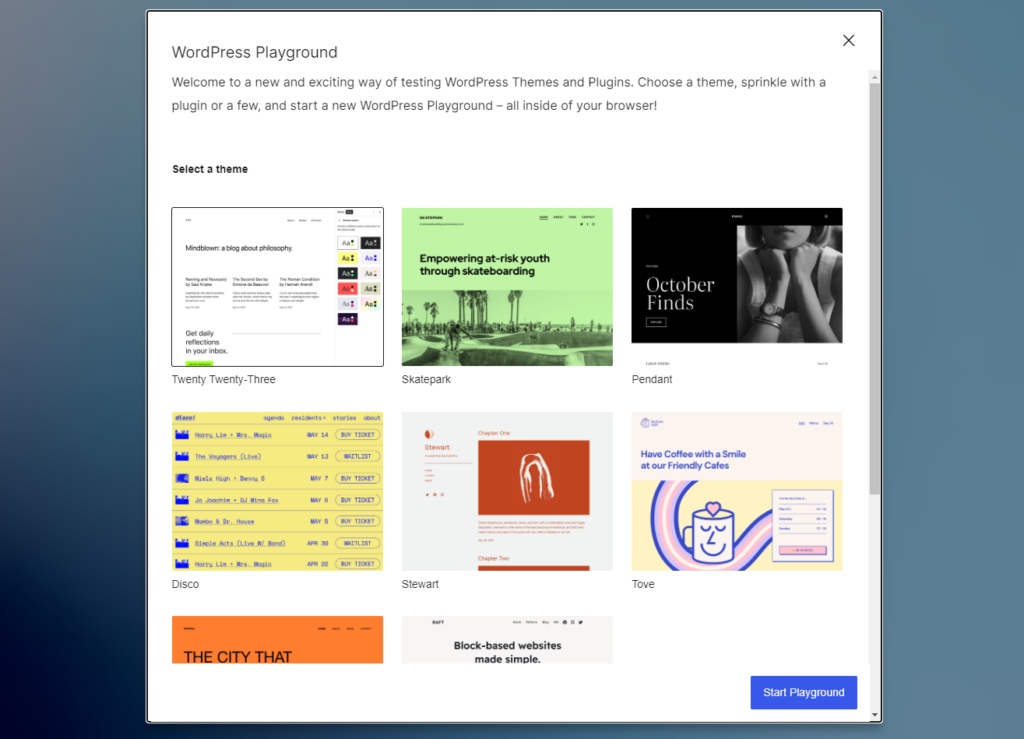Recap: State of the Word 2022


The State of the Word 2022, this year’s keynote address by WordPress co-founder Matt Mullenweg, took place on Thursday, December 15th. Mullenweg’s speech was presented live from New York City with a small in-house audience and also streamed live on YouTube and other platforms. If you didn’t catch the address at home or at one of the many local Meetup watch parties, here’s a recap with the key highlights and notable talking points.
WordPress in the world today
Josepha Haden Chomphosy, Executive Director of the WordPress project, spoke first, introducing Mullenweg to attendees. For nearly eight years, Chomphosy has worked behind the scenes as the lead of the open-source division at Automattic, the private company founded by Mullenweg. She kicked things off with reminders about the WordPress mission to democratize publishing and set the tone for the keynote, citing Mullenweg’s firm belief that “open-source is an idea that can change our generation.”

After taking the stage, Mullenweg started with some familiar statistics about the reach and dominance of WordPress as a content management system, noting more than 55,000 plugins and themes currently available in over 50 languages. He also mentioned the collaborative nature of WordPress development, using the metaphor “a software Amish barn raising” to illustrate how people come together to create a tool that benefits many.

The proliferation of Gutenberg
Mullenweg then moved into the topic of the Block Editor, predicting that Gutenberg will be bigger than WordPress itself. He presented examples of non-WordPress-related software applications that now incorporate Gutenberg. Prime examples include Laravel-based application builder Engine Awesome and the award-winning journaling app Day One.
He also mentioned Gutenberg integrations with the posting form on Tumblr, a social blogging platform purchased by Automattic in 2019. The name “Tumblr” came up quite a lot during the presentation, but more on that later.
Another surprise for me was the mention that another open-source CMS, Drupal, now leverages Gutenberg-based block editing software in parts of its code.
Meetups, WordCamps, and more
Mullenweg then presented an animated map showing the increasing number of WordPress meetups worldwide over time. He noted that after massive dropoffs during the height of the COVID-19 pandemic, WordPress Meetup groups doubled their events in 2022.

Also returning after a partial hiatus, there are 34 WordCamps in planning for 2023. These events were largely virtual for the past two years, so this increase signals increasing interest in organizing WordCamps. The flagship event for the Western Hemisphere, WordCamp US, will be held this year in National Harbor, Maryland, at the end of August.
Chances are this will be a pretty big celebration of all things WordPress, as the platform turns 20 years old next year. In honor of this milestone, the WordPress Community Summit is back, which brings “WordPress contributors, team leads, and diverse community voices” together to discuss the years ahead. A WordPress 20th Anniversary website has also been launched, promising more celebration details coming soon.
Looking back at 2022, and forward to WordPress in 2023
Before Mullenweg dove into a recap of new features developed and launched in 2022, he introduced some enhancements to the WordPress.org website. He noted that several key pages were redesigned and highlighted the recent launch of Showcase, a page exhibiting high-profile examples of WordPress-built sites.

He then celebrated the expansion of the WordPress-managed project Openverse, an extensive library of free stock photos, images, and audio available for free use. According to Mullenweg, the library now includes more than 600 million creative works and received 59 million requests within a 30-day period. The hope is that Openverse will soon be fully integrated into WordPress, making it easy for any user to incorporate its content into websites easily.
The relatively new Block Themes were covered, including a video demonstrating how they differ from more traditional WordPress themes. Mullenweg went through new developments in Styles for WordPress, noting how any website using a Block Theme now has access to dozens of variations on the structure.
Twenty Twenty-Three WordPress theme
One of the more engaging sections of the keynote was the overview of the Twenty Twenty-Three default WordPress theme. Mullenweg described it as a blank canvas with distinct style variations. Fluid typography and accessibility-ready features were highlighted as two of the major innovations. An introduction video was shown, which you can watch below.
Another theme innovation was acknowledged: the Create Block Theme Plugin. Made by WordPress developers. This plugin is for development purposes and is not ready for use on production websites. However, it allows you to create a new theme, preview font families, and embed local font assets in your theme during the creation process.
WordPress Patterns explained
Mullenweg explained one of the newest features of WordPress: Patterns. He described Patterns as a group of blocks that can be inserted simultaneously onto a page. For example, you can save a particular arrangement of header blocks, image blocks, dividers, and spacers into a layout that can be duplicated on multiple site pages.
These groups of blocks can be locked to prevent less-experienced users on the site from breaking the page structure. This feature is similar to another CMS, Squarespace, which now relies on page layouts that are essentially groups of blocks.
New taxonomies for plugin and theme directories
A new taxonomy for the plugin and theme directories was announced, so developers can identify how they intend to use the software they created. For example, users will have an easier time understanding whether a plugin is meant to be experimental or if a theme was created by a for-profit company. Mullenweg described a new distinction of “canonical” plugins: tools that are considered valuable by WordPress core developers and receive official security support. The “canonical” distinction will serve as a seal of approval for those who are risk-averse when trying new plugins.
What’s in store for Gutenberg Phase 3?
Several exciting features were announced for the next phase of Gutenberg, although no timelines or release dates were dropped. Mullenweg brought up exciting plans for making WordPress “multiplayer,” with real-time collaboration tools and on-page comments in the works, a la Google Docs. He also pointed to improving the post revisions history interface to be more useful and better workflows for the Media Library and its integrations with OpenVerse. Eventually, he made clear the plan is for every aspect of the WordPress core code to be multilingual.
The 2022 WordPress Survey was announced, where users can share their experiences from 2022 and provide feedback that can influence the direction and strategy for the WordPress project next year and beyond. Mullenweg explained that the survey questions had been refreshed for 2022, offering better survey flow and making the survey easier to complete.
WordPress Playground explained
The last major reveal was the announcement of WordPress Playground, a browser-based tool for experimentation. Users can start a new playground in a browser and tinker around with blocks and plugins to see what happens. These sites are temporary, and everything disappears when you close your browser tab. WordPress Playground is a virtual machine built in WebAssembly and puts it all in the local browser — no hosting needed.

One of the most interesting features of WordPress Playground is the ability to build single-click website clones, so you can experiment with design updates and plugins separately from your production website.
Big hopes for Tumblr
Throughout the keynote, the name Tumblr was mentioned many times. From a link to WordPress’s own Tumblr shared early in the speech to an appearance from a Tumblr employee during the Q&A that rounded out the live stream, Tumblr was everywhere. Mullenweg made clear he wants to keep WordPress as an influential part of the world for years to come, and it can be inferred that he believes Tumblr could be a big part of that.
For example, Mullenweg shared the link to his personal Tumblr, and his bio there reads that he’s “currently running Tumblr.” He shared some surprising information about Tumbler users, including that half its user base is under 25 years old, with 50,000 to 100,000 new signups per day. The plan is to position Tumblr as the social network for blogging, transitioning Tumblr’s framework to be powered by WordPress. He believes Tumblr can provide an onramp for a new generation of bloggers who sign up for the social component but begin learning WordPress simultaneously. Then users who later decide to expand and build their own websites will be trained and ready to choose WordPress as their CMS.
Interestingly, the top trending topic on Tumblr this week was Twitter, so it’s easy to imagine that, while not said aloud, the Automattic team may be preparing Tumblr for a comeback as more and more people search for a new microblogging home.
If you’re interested in watching the entire keynote speech, you can stream State of the Word 2022 on YouTube.
